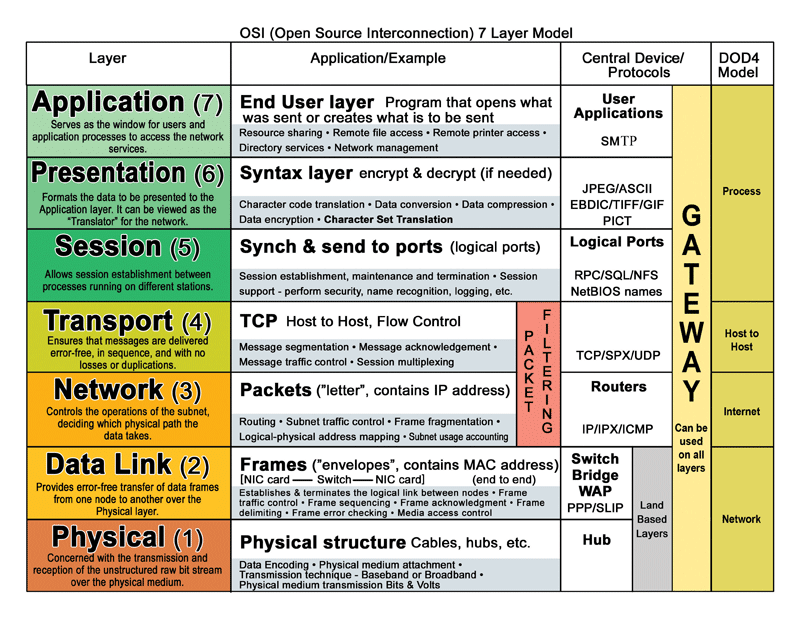Open Source Interconnection 7 Layer Model
Layers
Layer 1 - Physical
The physical layer defines the means of transmitting raw bits rather than logical data packets over a physical link connecting network nodes. The bit stream may be grouped into code words or symbols and converted to a physical signal that is transmitted over a hardware transmission medium. The physical layer provides an electrical, mechanical, and procedural interface to the transmission medium. The shapes and properties of the electrical connectors, the frequencies to broadcast on, the modulation scheme to use and similar low-level parameters, are specified here.
Within the semantics of the OSI network architecture, the physical layer translates logical communications requests from the data link layer into hardware-specific operations to affect transmission or reception of electronic signals.
Layer 2 - Data Link
The data link layer is concerned with local delivery of frames between devices on the same LAN. Data-link frames, as these protocol data units are called, do not cross the boundaries of a local network. Inter-network routing and global addressing are higher-layer functions, allowing data-link protocols to focus on local delivery, addressing, and media arbitration. This way, the data link layer is analogous to a neighborhood traffic cop; it endeavors to arbitrate between parties contending for access to a medium, without concern for their ultimate destination. When devices attempt to use a medium simultaneously, frame collisions occur. Data-link protocols specify how devices detect and recover from such collisions, and may provide mechanisms to reduce or prevent them.
Layer 3 - Network
The network layer is responsible for packet forwarding including routing through intermediate routers, since it knows the address of neighboring network nodes, and it also manages quality of service (QoS), and recognizes and forwards local host domain messages to the Transport layer (layer 4).
Layer 4 - Transport
The transport layer provides host-to-host communication services for applications. It provides services such as connection-oriented data stream support, reliability, flow control, and multiplexing.
Layer 5 - Session
The session layer provides the mechanism for opening, closing and managing a session between end-user application processes, i.e., a semi-permanent dialogue. Communication sessions consist of requests and responses that occur between applications. Session-layer services are commonly used in application environments that make use of remote procedure calls (RPCs).
Layer 6 - Presentation
The presentation layer is responsible for the delivery and formatting of information to the application layer for further processing or display. It relieves the application layer of concern regarding syntactical differences in data representation within the end-user systems. An example of a presentation service would be the conversion of an EBCDIC-coded text computer file to an ASCII-coded file.
Layer 7 - Application
The application layer is an abstraction layer that specifies the shared protocols and interface methods used by hosts in a communications network.
